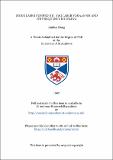Diode laser pumped Nd : YAG laser for 946-nm and its frequency doubling
Abstract
The development of a pulsed all-solid-state blue laser system is described in this thesis. The laser system was constructed on the basis of the latest diode laser pumping technology and the availability of the nonlinear material, potassium niobate, in single crystals of high optical quality. With the advantages of diode laser pumping, the 946-nm line in Nd:YAG was successfully made to lase at room temperature, both in cw and Q-switched operation. By frequency doubling the Q-switched 946-nm pulses in a KNbO3 nonlinear crystal, pulses of coherent blue light at a wavelength of 473 nm were obtained with high conversion efficiency. The 946 nm laser line differs from the more usual transitions used in the Nd:YAG laser in having a lower laser level in the ground state manifold. As a result it experiences significant reabsorption loss due to the (thermally excited) lower level population. Because of this reabsorption loss, the length of the crystal is an important parameter, and as a result of a trade-off between the pumping efficiency and the reabsorption loss, there is an optimum crystal length for every pump power level. A theoretical model was developed to describe this system, and with output coupler transmission, pump beam size and cavity mode size as parameters, optimum conditions for laser oscillation were obtained numerically. The theoretical model was tested with both a diode laser and a Ti:Sapphire laser as a pump source for the 946-nm laser. The theory was found to be in excellent agreement with the results. When pumping with the Ti:Sapphire laser, a slope efficiency of 58 % was obtained with a 2-mm long Nd:YAG crystal, but this dropped to about 11 % with diode laser pumping, which shows the advantage of pumping with a beam of high optical quality.The Q-switched version of the 946-nm Nd:YAG laser was also studied theoretically, and a modified four level model was developed to describe the dynamic behaviour of the laser in the presence of lower state reabsorption. The relation of this quasi-three level model to the ideal four level model used in the absence of such absorption was explored. The experiments on Q-switching described here were the first to be reported on the application of this technique to a diode laser pumped 946-nm Nd:YAG laser. Q-switching was achieved by a Brewster-angled acoustic-optic Q-switch, which also acted as a linear polariser. When the laser was pumped by a 0.5 W diode-laser array, pulses with an energy of 4.9 muJ and pulse duration of 68.5 ns were observed at room temperature. Cooling the Nd:YAG crystal to 5 °C improved the laser performance to give pulses of 5.6 muJ pulse energy and 62 ns pulse duration, corresponding to peak powers of 76 W. The pulse repetition rate was kept at 1.5 kHz throughout. Blue light was generated by passing the 946-nm laser pulses along the a-axis of a 5.1-mm long potassium niobate nonlinear crystal, which was kept at 185 °C to obtain noncritical phase matching. The nonlinear coefficient used in this case was d32 (~19.5 pm/V 946 nm). Problems connected with crystal depoling were successfully solved both by the use of a uniform and well controlled temperature environment for the crystal and by providing a poling electric field during heating/cooling. Pulses of coherent blue light at 473 nm with 42 ns duration and 22 W peak power were generated from the output of the 946 nm laser described above, corresponding to an internal peak-power conversion efficiency of 40%, which was in excellent agreement with the second-harmonic-generation theory.
Type
Thesis, PhD Doctor of Philosophy
Collections
Items in the St Andrews Research Repository are protected by copyright, with all rights reserved, unless otherwise indicated.

